| dc.contributor.advisor | Τζαβελάς, Γεώργιος | |
| dc.contributor.author | Πατμίου, Αναστασία | |
| dc.date.accessioned | 2023-10-24T11:01:46Z | |
| dc.date.available | 2023-10-24T11:01:46Z | |
| dc.date.issued | 2023-09 | |
| dc.identifier.uri | https://dione.lib.unipi.gr/xmlui/handle/unipi/15833 | |
| dc.identifier.uri | http://dx.doi.org/10.26267/unipi_dione/3255 | |
| dc.description.abstract | Το μοντέλο δόσης-απόκρισης μελετά τον τρόπο με τον οποίο μια ουσία ή ένα φάρμακο επηρεάζει ένα βιολογικό σύστημα, σε σχέση με την ποσότητα της δόσης που χορηγείται. Bοηθάει στο να κατανοήσουμε κατά πόσο η απόκριση αυξάνεται ή μειώνεται ανάλογα με την χορήγηση της δόσης και εφαρμόζεται σε ποικίλους τομείς. Σκοπός του μοντέλου αυτού είναι η καλύτερη εκτίμηση της αποτελεσματικότητας και ασφάλειας των φαρμάκων και άλλων χημικών ουσιών, συμβάλλοντας στη βελτίωση της φαρμακευτικής αγωγής και της υγείας του ανθρώπου.
Στο πρώτο κεφάλαιο, εξετάζεται η έννοια και η μοντελοποίηση του μοντέλου δόσης-απόκρισης, η διερεύνηση των διαφορετικών μετρήσεων (ED_50 κλπ) και η μελέτη των ποικίλων καμπυλών δόσης-απόκρισης. Όλα τα γραφήματα που περιλαμβάνονται σε αυτό το κεφάλαιο έχουν αναπαραχθεί με την χρήση των πακέτων Microsoft Excel και R.
Στο δεύτερο κεφάλαιο, γίνεται η μαθηματική ανάλυση των μοντέλων δόσης-απόκρισης. Σε αυτή την ενότητα εξετάζονται τα διαφορετικά μοντέλα δόσης-απόκρισης, οι συναρτήσεις σύνδεσης και η γενίκευσή τους, καθώς και η παλινδρόμηση τριών παραμέτρων.
Το τρίτο κεφάλαιο περιέχει εφαρμογές των διαφόρων μοντέλων με την χρήση του στατιστικού πακέτου R. Χρησιμοποιείται η βιβλιοθήκη drc από την οποία και αντλούμε το μεγαλύτερο ποσοστό των δεδομένων μας. Πιο συγκεκριμένα στην ενότητα αυτή γίνεται σύγκριση τον μοντέλων logit, probit και cloglog (δεδομένα από τους : Jeske, D. R., Xu, H. K., Blessinger, T., Jensen, P. and Trumble, J. (2009)), μελετάται η συνεχής απόκριση όταν έχουμε μια καμπύλη δόσης-απόκρισης (δεδομένα από τους : Inderjit and J. C. Streibig, and M. Olofsdotter (2002)) και δύο καμπύλες δόσης-απόκρισης (δεδομένα από τους : Christensen, M. G. and Teicher, H. B., and Streibig, J. C. (2003)), και τέλος εξετάζεται η διωνυμική απόκριση με την χρήση μη γραμμικής παλινδρόμησης (δεδομένα από την : Nina Cedergreen (2013)).
Τέλος, γίνεται μια ανασκόπηση των αποτελεσμάτων που έχουμε βρεί από κάθε εφαρμογή, με σκοπό την σημείωση των βασικών συμπερασμάτων στα οποία οδηγηθήκαμε μετά την ανάλυση. | el |
| dc.format.extent | 86 | el |
| dc.language.iso | el | el |
| dc.publisher | Πανεπιστήμιο Πειραιώς | el |
| dc.rights | Αναφορά Δημιουργού-Μη Εμπορική Χρήση-Όχι Παράγωγα Έργα 3.0 Ελλάδα | * |
| dc.rights.uri | http://creativecommons.org/licenses/by-nc-nd/3.0/gr/ | * |
| dc.title | Τo μoντέλο δόση - απόκριση και οι εφαρμογές του στην βιοστατιστική | el |
| dc.title.alternative | The dose response model and its application to biostatistics | el |
| dc.type | Master Thesis | el |
| dc.contributor.department | Σχολή Χρηματοοικονομικής και Στατιστικής. Τμήμα Στατιστικής και Ασφαλιστικής Επιστήμης | el |
| dc.description.abstractEN | The dose-response model examines how a substance or drug influences a biological system concerning the amount of dose administered. It aids in determining whether the response increases or decreases in proportion to the given dose and finds applications across multiple domains. This model's objective is to enhance the appraisal of drug and chemical substance efficacy and safety, thereby contributing to refining pharmaceutical treatment and human well-being.
In the initial chapter, we delve into the concept and modeling of the dose-response model, explore different measurements like ED_50, and analyze various dose-response curves. All graphs featured in this chapter are generated utilizing Microsoft Excel and R software.
The subsequent chapter entails the mathematical scrutiny of dose-response models. This segment assesses distinct dose-response models, link functions, their extensions, and the regression involving three parameters.
The third chapter contains applications of various models using the statistical package R. We utilize the drc library, from which we extract the majority of our data. More specifically, in this section, we compare the logit, probit, and cloglog models (data from: Jeske, D. R., Xu, H. K., Blessinger, T., Jensen, P., and Trumble, J. (2009)). We examine continuous response when we have a dose-response curve (data from: Inderjit and J. C. Streibig, and M. Olofsdotter (2002)), and two dose-response curves (data from: Christensen, M. G. and Teicher, H. B., and Streibig, J. C. (2003)). Finally, we investigate binomial response using non-linear regression (data from: Nina Cedergreen (2013)).
Ultimately, we provide an overview of the outcomes derived from each application, aiming to encapsulate the fundamental findings reached post-analysis. | el |
| dc.contributor.master | Εφαρμοσμένη Στατιστική | el |
| dc.subject.keyword | Δόση | el |
| dc.subject.keyword | Απόκριση | el |
| dc.subject.keyword | Βιοστατιστική | el |
| dc.subject.keyword | Συγκέντρωση | el |
| dc.subject.keyword | Μοντέλο | el |
| dc.date.defense | 2023-09-25 | |



